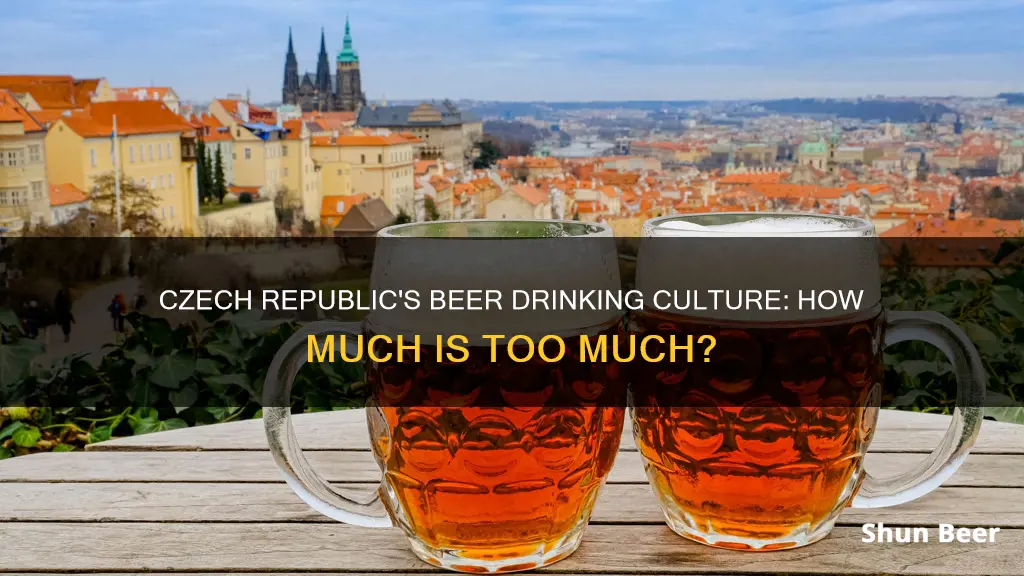
The Czech Republic has the highest beer consumption per capita in the world. In 2013, the average Czech person drank 147 litres of beer, nearly 40 litres more than any other nationality. Beer is often cheaper than water, and it's common to drink during lunch breaks and at celebrations and festivals. The country's unique drinking culture is reflected in its beer-pouring techniques, categorisation of beer by degrees, and the tradition of drinking in pubs as a social activity.
| Characteristics | Values |
|---|---|
| Beer consumption per capita | The highest in the world |
| Beer consumption per person per year | 147 litres (2013) to 161 litres |
| Beer price | Less than $1 for 0.5 litres |
| Beer price compared to water | Cheaper than bottled water |
| Beer types | Pilsner, lager, dark beer, dopplebocks, porters, pale ales, amber brews, wheat beer, craft beer |
| Beer brands | Pilsner Urquell, Staropramen, Budvar, Gambrinus, Krušovice, Bernard, Svijany, U Fleků, Radegast, Ostravar, Velvet, Březňák, Zlatopramen, Lobkowicz, Primius, etc. |
| Beer ABV | 3-9% |
| Beer degrees | 10, 12, 16, 20+ |
| Beer foam | Highly valued |
| Beer drinking culture | Socialising with friends or colleagues, not partying all night |
| Beer drinking etiquette | Say "na zdraví" when toasting, make eye contact, don't cross arms |
| Beer serving style | Hladinka, mlìko, Šnyt |
What You'll Learn

Czech Republic's beer consumption per capita
The Czech Republic has the highest beer consumption per capita in the world. In 2021, the country topped the list with 140.12 litres of beer consumed per capita. This is significantly higher than the average American, who drinks 76 litres per year, and the average UK resident, who consumes 67 litres. In 2013, the average Czech person drank 147 litres of beer, nearly 40 litres more than any other nationality.
The Czech Republic's love for beer is well-known, and the country is often referred to as the "beer capital of the world". Beer is deeply ingrained in the local culture and is considered a matter of national pride. It is also incredibly affordable, often cheaper than any other beverage, including bottled water, in restaurants and pubs. In fact, the Czech government has implemented a rule that at least one non-alcoholic drink must be cheaper than beer.
The country's long history of brewing also contributes to its high consumption rates. Brewing traditions date back to the 10th century when monks began brewing beer in monasteries. Over time, the art of brewing spread throughout the region, and by the early 20th century, there were over 1,000 breweries in the small nation.
While beer consumption in the Czech Republic has been on a downward trend in recent years, with the 2023 consumption of 128 litres per capita being the lowest since 1963, the country still holds the top spot for per-capita consumption globally.
German Beer Culture: Cans or Glasses?
You may want to see also

Beer is cheaper than bottled water
The Czech Republic is a paradise for beer lovers. The country has the highest beer consumption per capita in the world, with the average Czech adult drinking 160 litres of beer per year. Beer is also often cheaper than any other beverage in a restaurant, with a 0.33-litre bottle of water costing around 49 CZK at Lokál, where 0.3 litres of beer is 48 CZK. In restaurants, beer used to be cheaper than water, but now, there is a government rule that at least one non-alcoholic beverage must be cheaper than beer.
The Czechs' love for beer can be traced back to the 10th century when brewing began in monasteries. When monks started to produce more beer than they could consume, they began to sell it, and this is how breweries started to grow. By the early 20th century, there were over 1,000 breweries in the country. Today, there are hundreds of breweries in the Czech Republic, and many restaurants or pubs have their own unique microbreweries.
The Czechs' passion for beer is so strong that it is considered a matter of national pride. Former President Václav Havel commented that Czechs are more reserved than most nationalities because beer drinkers tend to be more passive than those who prefer stronger alcoholic drinks. In fact, in Jaroslav Hašek’s beloved book, *The Good Soldier Švejk*, he remarked that any government that raises the price of beer is sure to collapse.
The Czechs' dedication to their beer culture is evident in the variety of beers available, the unique drinking etiquette, and the importance of beer in social gatherings and celebrations. Beer is so ingrained in the country's culture that it is common to drink beer during lunch breaks at work and even while walking on the streets.
So, if you're ever in the Czech Republic, remember that beer is often cheaper than bottled water, and it's considered rude to refuse a drink!
Stein Servings: How Many Standard Drinks?
You may want to see also

Czech Republic's Budweiser
The Czech Republic is a paradise for beer lovers, with the highest per-capita beer consumption in the world. The average Czech adult drinks 147 litres of beer per year, or 160 litres according to another source. Beer is deeply ingrained in the local culture, and the country is home to the original Budweiser.
The Budweiser trademark is the subject of an ongoing dispute between two beer companies, one from the Czech Republic and the other from the United States. The dispute, which has been ongoing since 1907, centres around trademark and geographic origin rights to the name "Budweiser".
The Czech Budweiser, Budweiser Budvar, is a bitter, refreshing, full-bodied beer with herbal notes and a distinct peppery finish. It is brewed in the city of České Budějovice (Budweis in German) using artesian water, Moravian barley, and Saaz hops. Budweiser Budvar is the fourth-largest beer producer in the Czech Republic and the second-largest exporter of beer abroad. The name is a portmanteau of "Budějovický Pivovar", meaning "Budweis Brewery".
The history of brewing in České Budějovice dates back to 1265, when Ottokar II, King of Bohemia, granted the city brewing rights. At one point, the city was the imperial brewery of the Holy Roman Empire. To promote the quality of the drink, nearby towns were forbidden from brewing. To distinguish Budweis beer from that coming from other regions, it was called Budweiser Bier ("beer from Budweis" in German).
The American Budweiser, on the other hand, is produced by Anheuser-Busch, which was founded by a German immigrant to the United States named Adolphus Busch. Busch encountered the Czech Budweiser often during his visits to Europe and decided to name his own beer Budweiser, brewing it according to the Bohemian process.
Beer and Wheat Allergies: Is Drinking Safe?
You may want to see also

Beer is poured three ways
Czech beer foam is a particular way of serving beer, and the art of pouring beer is taken very seriously in the Czech Republic. There are three ways to order a beer at the bar, depending on your foam preferences.
Hladinka
The standard pour is a hladinka, with about one-quarter foam on top of the glass. It's poured in one go and is the perfect creamy ratio of beer-to-head. Once you've finished, it should leave circles of foam down the inside of the glass.
Šnyt
If you're not in the mood for a full beer, you can order a šnyt. It's a small beer served in a large mug that's filled with foam to save the drinker the embarrassment of ordering a small beer. The thick layer of foam also keeps the beer fresh, so a šnyt can be enjoyed slowly.
Mlíko
Your third option is mlíko, in which a tiny bit of beer is poured and then topped with a glass full of froth. These are typically drunk at the end of the night, with the sweetness of the froth said to give the drinker a 'jolt of energy' so they can make it home (responsibly). If you order a mlíko, be sure to drink it quickly to enjoy the full flavour of the froth before it settles into a regular beer taste.
Beer and Keto: Weight Loss Friend or Foe?
You may want to see also

Beer is measured in degrees
The Czech Republic has the highest beer consumption per capita in the world. The average Czech adult drinks 160 litres of beer per year, which works out to more than a 12-oz. (355 ml) beer each day. Beer is so important to the local culture that it's considered a matter of national pride.
Beer in the Czech Republic is categorised according to the Balling scale (or Plato scale), which is a measure of gravity or density on the day the beer was brewed. This is expressed as a weight percentage of sucrose and indicates the percent by weight of extract (sucrose) in a solution. For example, a 10-degree beer is 10 degrees Balling, meaning it has 10% sucrose.
The most popular beverage in the Czech Republic is 12-degree beer, which is a regular lager. A 10-degree beer is also lager but with a weaker extract, meaning you can drink more of it. Higher-degree beers are stronger in taste and alcohol content. For example, a 10-degree beer is about 4% alcohol, while a 12-degree beer is about 5%.
The Balling scale differs slightly from the Plato scale in terms of the temperature at which the measurement of specific gravity is taken. The Balling scale uses a temperature of 17.5°C, while the Plato scale uses 20°C. The Plato scale is used by most brewers worldwide, although brewers in the UK and those using British brewing traditions prefer to use the specific gravity scale instead.
Drinking Beer While Driving a Lawnmower: Is It Legal?
You may want to see also
Frequently asked questions
Czech people drink more beer per capita than any other country in the world. The average Czech adult drinks 147-161 liters of beer per year.
In 2013, the average American drank 76 liters of beer per year, and the average UK resident drank 67 liters.
Beer is often cheaper than any other beverage in a restaurant in the Czech Republic. In Prague, beer can cost as little as 14 koruna a pint (around $0.80 or €0.54), whereas bottled water can cost around 35 koruna for a 0.33-liter bottle.
Beer consumption in the Czech Republic has been declining. In 2023, beer production fell by 8% from the previous year, reaching its lowest level since 1989.







